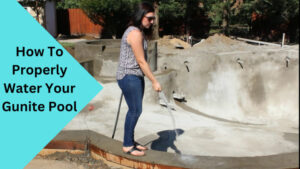Welcome to the complete guide on how to properly water your gunite pool. To ensure your pool remains pristine, inviting, and functional for years to come, understanding the best watering practices is key. In this comprehensive guide, we will cover everything you need to know about maintaining the water quality and preventing common pool issues. From determining the ideal watering frequency to troubleshooting problems like sticky pool water and brown discoloration from fallen leaves, let’s dive in and explore the world of gunite pool watering!
Why Proper Watering is Essential for Gunite Pools
Before we delve into the specifics, let’s highlight why proper watering is crucial for gunite pools. Gunite pools are constructed with a mixture of cement, sand, and water, resulting in a durable and long-lasting structure. However, maintaining the correct water balance is vital to extend the lifespan of your pool and keep it looking its best. Neglecting proper watering techniques can lead to a range of issues such as cracks, leaks, discoloration, and even structural damage. By following the guidelines provided in this blog post, you’ll be equipped with the knowledge needed to ensure your gunite pool remains a beautiful oasis.
How Often Should You Wet a Gunite Pool?
One of the most common questions pool owners have is, “How often should you wet a gunite pool?” The answer depends on various factors, such as climate, pool usage, and maintenance routine. Generally, it is recommended to wet your gunite pool at least once every two weeks. However, this frequency may vary in regions with extremely hot or dry climates. By keeping the pool moist, you minimize the risk of surface cracks and ensure the gunite remains in optimal condition.
Taking Care of Your Gunite Pool: Best Practices

Proper maintenance and care are essential for preserving the integrity of your gunite pool. Here are some best practices to follow:
-
Checking and Adjusting Water Levels Regularly
To maintain the ideal water level, regularly check and adjust it as required. Low water levels can strain the pool pump and filtration system, leading to inefficient circulation. On the other hand, excessive water levels can cause overflow and potential damage to surrounding structures. Periodically monitor the water levels and make adjustments based on recommendations from the pool manufacturer.
-
Maintaining Optimal pH Levels
pH levels play a crucial role in the overall water quality of your gunite pool. Aim to maintain a pH level between 7.4 and 7.6, slightly on the alkaline side. This range ensures swimmer comfort, helps prevent corrosion or scale formation on pool surfaces, and maximizes the effectiveness of sanitizers and other pool chemicals. Test the pH levels regularly using a reliable test kit and make necessary adjustments using pH increasers or decreasers.
-
Treating Algae and Bacteria Buildup
Algae and bacteria can quickly proliferate in poorly maintained pools, leading to unsightly green or slimy water. Regularly shock your pool to kill off any potentially harmful microorganisms and prevent the growth of algae. Additionally, use an algaecide to inhibit algae growth and keep your pool looking crystal clear. Follow the manufacturer’s instructions for dosage and application.To explore more details and considerations regarding Algae, our comprehensive guide on Can Algae Stain a Gunite Pool? Nightmare or Solved Mystery? has you covered.
-
Skimming and Cleaning Debris
Leaves, insects, and other debris can accumulate on the surface of your gunite pool, causing water discoloration and clogged filters. Use a skimmer net to remove any visible debris regularly. Additionally, invest in a reliable pool vacuum or automatic cleaner to ensure thorough cleaning of the pool floor and walls. By keeping your pool free from debris, you’ll maintain better water circulation and reduce the risk of waterborne diseases.
What Makes a Gunite Pool Waterproof?
Gunite pools are renowned for their exceptional waterproofing qualities. But what exactly makes a gunite pool waterproof? The answer lies in the construction process. During the pool’s construction, skilled professionals use a high-pressure spraying technique to apply a mixture of cement, sand, and water to form a thick, solid shell. This method creates a monolithic structure that is highly resistant to water penetration. Additionally, a waterproof plaster or finishing material is applied to the gunite surface, further enhancing the pool’s waterproofing capabilities.To explore more details and considerations regarding waterproof a gunite pools, our comprehensive guide on How to Waterproof a Gunite Pool: Essential Guide to Protecting Your has you covered.
Can Water Seep Through Gunite? Understanding Water Seepage
While gunite pools are designed to be waterproof, it is essential to understand the concept of water seepage. Water seepage refers to the gradual penetration of water through the microscopic pores or cracks in the gunite surface. Though minimal, this seepage can occur over time, leading to increased water consumption and, in some cases, structural issues. To minimize water seepage, ensure proper maintenance, and promptly address any visible cracks or imperfections in the pool shell. Regular application of a high-quality waterproofing sealant can also help reinforce the waterproofing barrier and mitigate seepage concerns.
Troubleshooting Common Issues
Pool Water Feeling Sticky
If your pool water feels sticky, it can be an indication of an imbalance in the pool’s water chemistry. This phenomenon is usually caused by excessive levels of chloramines, which are formed when chlorine combines with sweat, oils, or urine in the water. To remedy this issue, shock the pool with a chlorine-based shock treatment, following label instructions carefully. Additionally, make sure the pool’s filtration system is functioning optimally, and regularly clean the filter to maintain proper circulation and filtration.
Pool Water Turning Brown from Leaves
Leaves and other organic matter falling into your pool can cause the water to turn brown or discolored. Not only is this visually unappealing, but it can also affect the pool’s water balance. To address this issue, regularly skim the pool surface to remove leaves and debris. Consider using a pool cover during seasons with heavy leaf litter to prevent organic matter from entering the pool. If the water has already turned brown, adjusting the pool’s pH levels and using a pool clarifier can help restore its clarity.
Conclusion
Maintaining a gunite pool is a worthwhile investment, and proper watering practices are essential for its longevity, appearance, and functionality. By following the guidelines outlined in this blog post, you can ensure that your gunite pool remains a sparkling oasis for your enjoyment.
From understanding optimal watering frequency to implementing a comprehensive maintenance routine, you now have the knowledge to care for your gunite pool with confidence. Remember to regularly check water levels, maintain pH balance, treat algae and bacteria buildup, and address any potential issues promptly. Here’s to many years of enjoyment in your beautifully maintained gunite pool!

Greetings, fellow pool enthusiasts! I’m Turner Davis, your dedicated guide to the world of pool care and maintenance. With over a decade of experience in the field, I’ve made it my mission to transform ordinary pools into extraordinary aquatic retreats.

